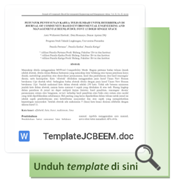STRATEGY OF ECOREGION PROTECTION AND MANAGEMENT, CASE STUDY OF TASIKMALAYA CITY
DOI:
https://doi.org/10.23969/jcbeem.v5i1.3773Keywords:
ecoregion, sustainable development, Tasikmalaya City, DPSIR (Driving Forces-Pressure-State-Impacts-Response)Abstract
The Tasikmalaya City Ecoregion Protection and Management Strategy is a planning study aimed to support other developments, in accordance with the mandate of Law Number 32 of 2009 concerning Environmental Protection and Management. The purpose of this document is to provide an indication of the policy direction for environmental protection and management plans in the Tasikmalaya City based on the results of an analysis of the main challenges and strategic issues that refer to an environmental inventory at the ecoregion level in the Tasikmalaya City. The preparation of this document is intended to provide direction, reference and basis for development in the Tasikmalaya City based on the potential, availability, limitations of ecosystem services and natural resources in the Tasikmalaya City which are manifested in the threshold and status of the carrying capacity and the carrying capacity of the environment. Based on this status, policy interventions and program directions for environmental management and protection can be further formulated as a controller of development in Tasikmalaya City. The study is structured through the following stages: (1) data collection, thematic maps, and related literature, (2) Situational Analysis for the formulation of the main challenges and strategic environmental issues in Tasikmalaya City, using a spatial analysis framework, followed by DPSIR analysis (Driving Forces-Pressure-State-Impacts-Response) to identify the root causes of strategic issues of environmental protection and management, formulate their impact on community welfare and formulate policies and program directions as interventions in environmental protection and management.
Downloads
References
Bailey, R.G. (2005). Identifiying Ecoregion Boundaries. Environmental Management. Vol. 34(Suppl.1), S14-S26.
Carr, E.R., Wingard, P.M., Yorty, S.C., Thompson, M.C., Jensen, N.K., Roberson, J. (2007) Applying DPSIR to Sustainable Development. International Journal of Sustainable Development & World Ecology. Vol 14, 543-555.
Magsi, H., Torre, A., Liu, H., Sheikh, M.J. (2017). Landuse Conflicts in the Developing Countries: Proximate Driving Force and Preventive Measure. Pakistan Development Review. Vol 56(1), 19-30.
Ramadanta, A., Basri, I.S. (2011). Pendekatan Ecoregion dalam Pengembangan Kawasan Wisata Studi Kasus Penataan Kawasan Wisata Danau Poso. Jurnal “ruang”. Vol. 3(1), 1-13.
Subekti, S. (2016). Rencana Perlindungan dan Pengelolaan Hidup Provinsi Kalimantan Selatan. Jurnal Neo Tenika. Vol. 2(1), 17-26.
Wang, Z., Zou, J., Loaiciga, H., Guo, H., Hong, S. (2015). A DPSIR Model for Ecological Security Assessment through Indicator Screening: A Case Study at Dainchi Lake in China. Plos One. DOI:10.1371/journal.pone.0131732














